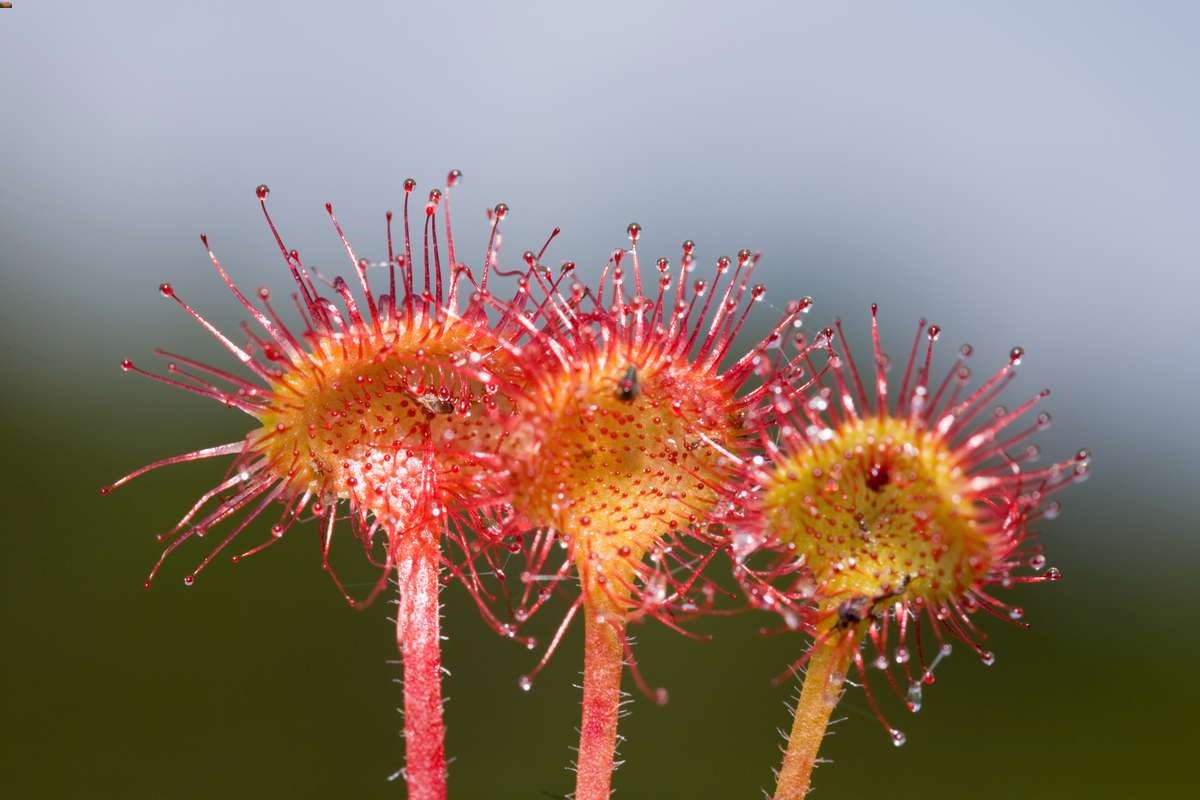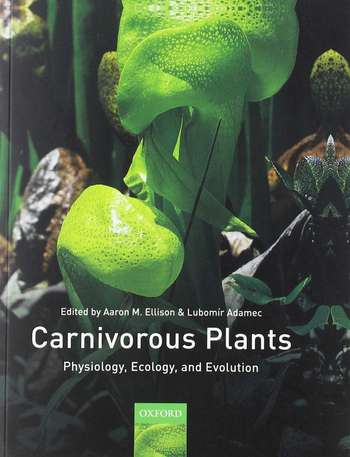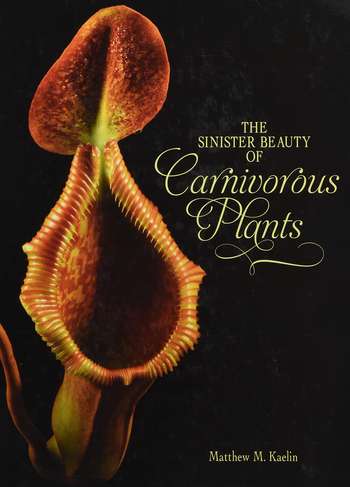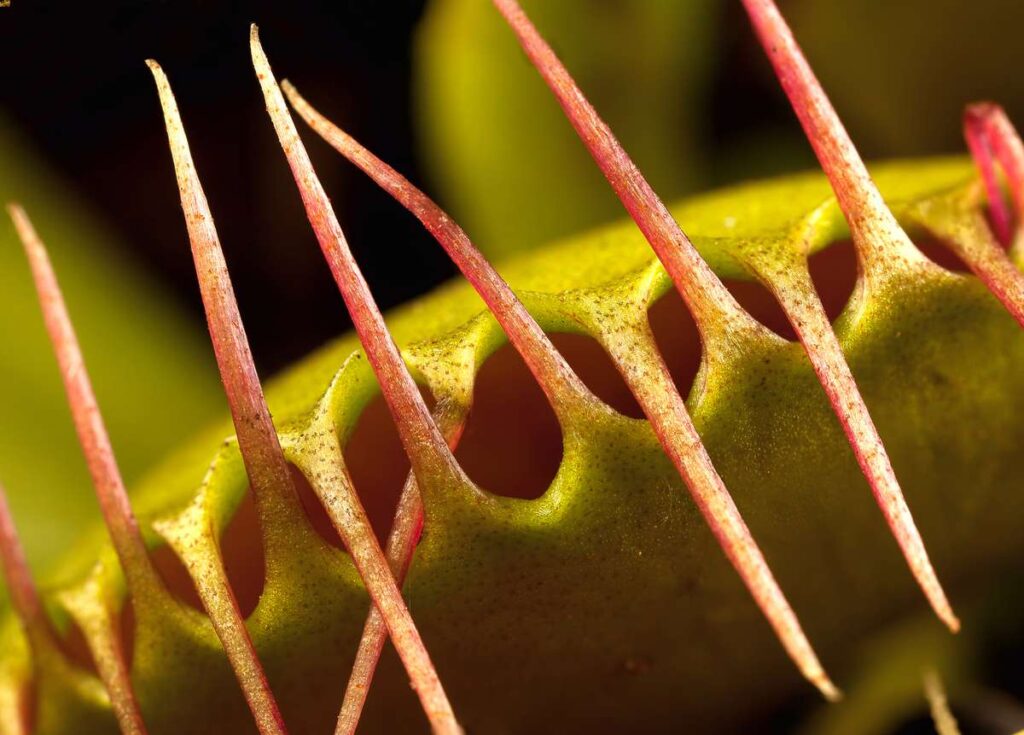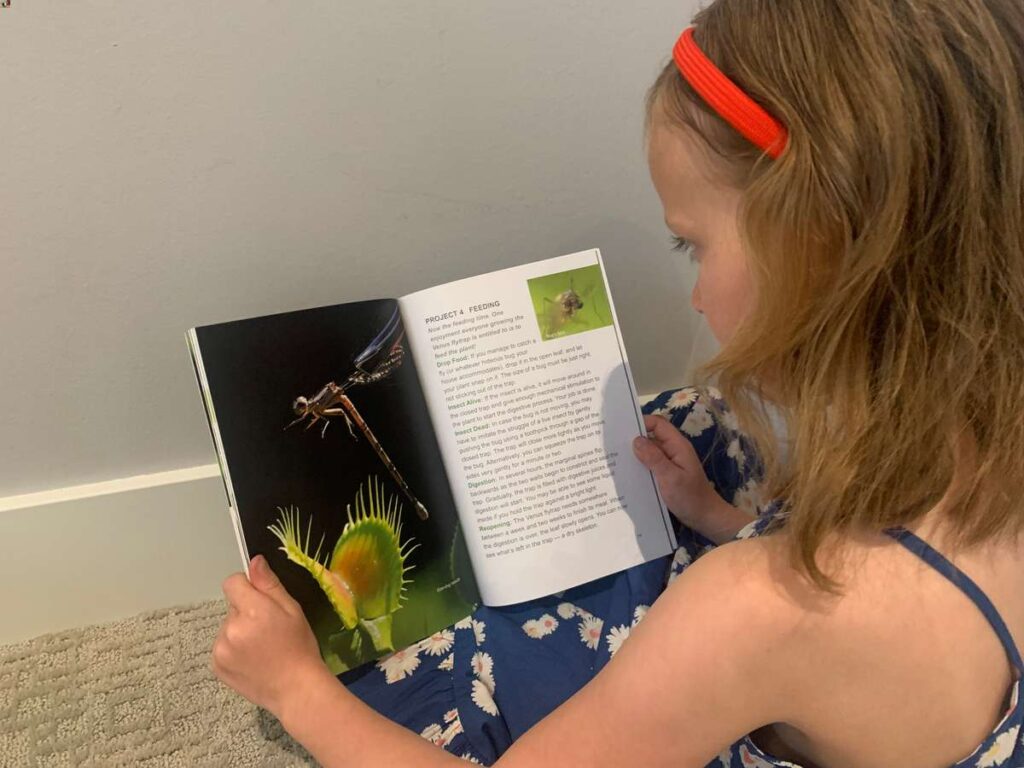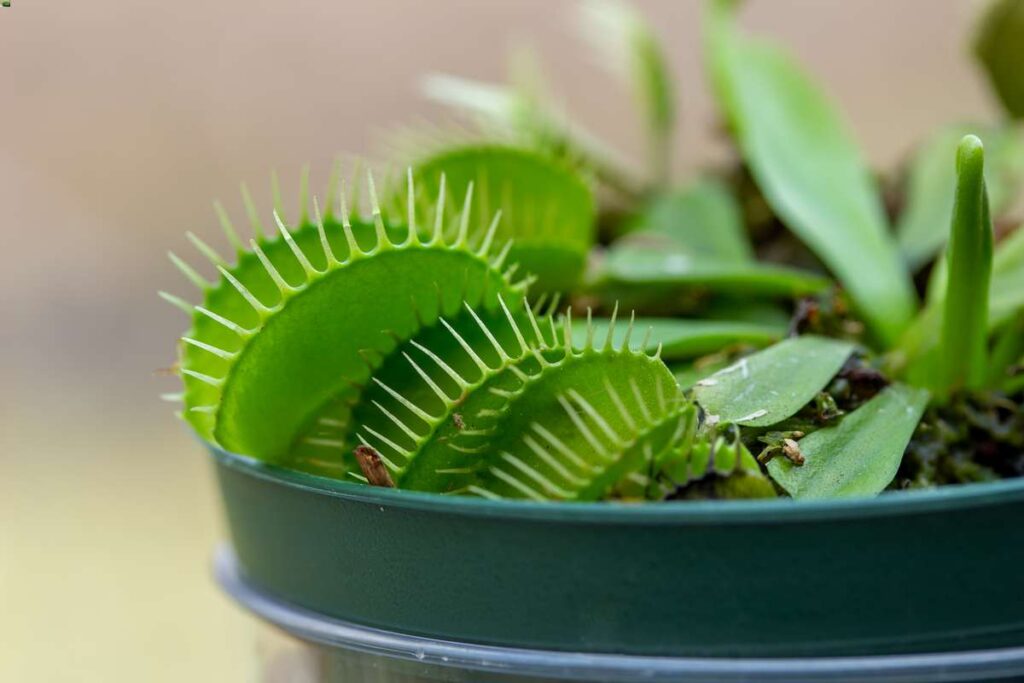Welcome carnivorous plant fans! This free, illustrated version of Chapter 3 of Insectivorous Plants by Charles Darwin has been lightly edited to be more internet friendly. The main text of Chapter 3 of Insectivorous Plants is presented here in its entirety; we have simply removed some of the table of contents material, created more white space for easier reading, added a color picture or two, etc.
We hope you enjoy this free, online version of the Charles Darwin book Insectivorous Plants, Chapter 3.
This post contains compensated links.
CHAPTER 3
AGGREGATION OF THE PROTOPLASM WITHIN THE CELLS OF THE TENTACLES
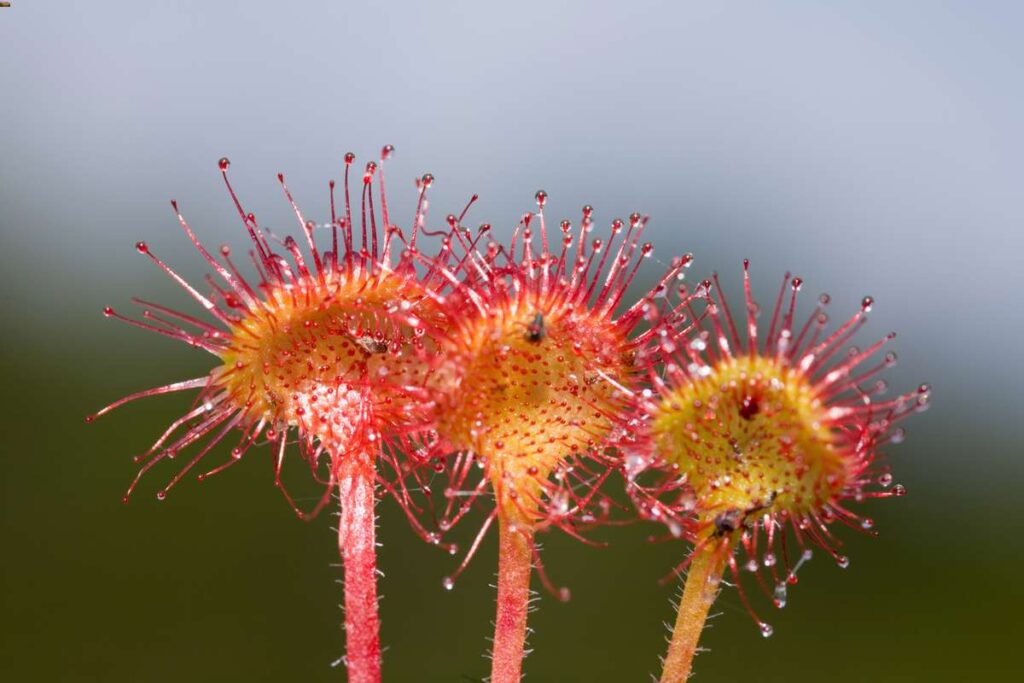
Insectivorous Plants – Chapter 3 Topics:
- Nature of the contents of the cells before aggregation
- Various causes which excite aggregation
- The process commences within the glands and travels down the tentacles
- Description of the aggregated masses and of their spontaneous movements
- Currents of protoplasm along the walls of the cells
- Action of carbonate of ammonia
- The granules in the protoplasm which flows along the walls coalesce with the central
masses - Minuteness of the quantity of carbonate of ammonia causing aggregation
- Action of other salts of ammonia
- Of other substances, organic fluids, &c.
- Of water
- Of heat
- Redissolution of the aggregated masses
- Proximate causes of the aggregation of the protoplasm
- Summary and concluding remarks
- Supplementary observations on aggregation in the roots of plants.
I WILL here interrupt my account of the movements of the leaves, and describe the phenomenon of aggregation, to which subject I have already alluded. If the tentacles of a young, yet fully matured leaf, that has never been excited or become inflected, be examined, the cells forming the pedicels are seen to be filled with homogeneous, purple fluid.
The walls are lined by a layer of colourless, circulating protoplasm; but this can be seen with much greater distinctness after the process of aggregation has been partly effected than before.
The purple fluid which exudes from a crushed tentacle is somewhat coherent, and does not mingle with the surrounding water; it contains much flocculent or granular matter. But this matter may have been generated by the cells having been crushed; some degree of aggregation having been thus almost instantly caused.
If a tentacle is examined some hours after the gland has been excited by repeated touches, or by an inorganic or organic particle placed on it, or by the absorption of certain fluids, it presents a wholly changed appearance. The cells, instead of being filled with homogeneous purple fluid, now contain variously shaped masses of purple matter, suspended in a colourless or almost colourless fluid.
The change is so conspicuous that it is visible through a weak lens, and even sometimes by the naked eye; the tentacles now have a mottled appearance, so that one thus affected can be picked out with ease from all the others. The same result follows if the glands on the disc are irritated in any manner, so that the exterior tentacles become inflected; for their contents will then be found in an aggregated condition, although their glands have not as yet touched any object.
But aggregation may occur independently of inflection, as we shall presently see. By whatever cause the process may have been excited, it commences within the glands, and then travels down the tentacles. It can be observed much more distinctly in the upper cells of the pedicels than within the glands, as these are somewhat opaque.
Shortly after the tentacles have re-expanded, the little masses of protoplasm are all redissolved, and the purple fluid within the cells becomes as homogeneous and transparent as it was at first. The process of redissolution travels upwards from the bases of the tentacles to the glands, and therefore in a reversed direction to that of aggregation.
Tentacles in an aggregated condition were shown to Prof. Huxley, Dr. Hooker, and Dr. Burdon Sanderson, who observed the changes under the microscope, and were much struck with the whole phenomenon.
The little masses of aggregated matter are of the most diversified shapes, often spherical or oval, sometimes much elongated, or quite irregular with thread- or necklace-like or club-formed projections. They consist of thick, apparently viscid matter, which in the exterior tentacles is of a purplish, and in the short distal tentacles of a greenish, colour.
These little masses incessantly change their forms and positions, being never at rest. A single mass will often separate into two, which afterwards reunite. Their movements are rather slow, and resemble those of Amoebae or of the white corpuscles of the blood. We may, therefore, conclude that they consist of protoplasm. I
f their shapes are sketched at intervals of a few minutes, they are invariably seen to have undergone great changes of form; and the same cell has been observed for several hours. Eight rude, though accurate sketches of the same cell, made at intervals of between 2 m. or 3 m., are here given (fig. 7), and illustrate some of the simpler and commonest changes.
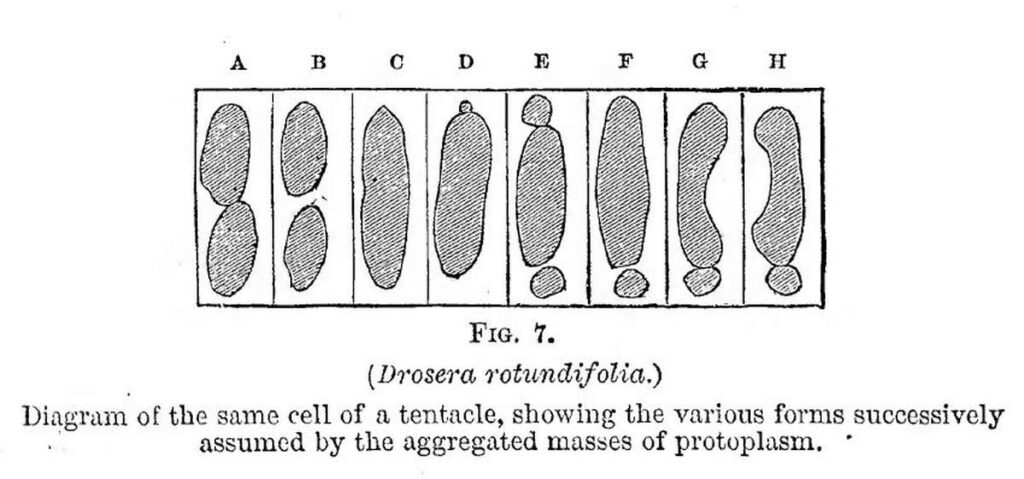
The cell A, when first sketched, included two oval masses of purple protoplasm touching each other. These became separate, as shown at B, and then reunited, as at C. After the next interval a very common appearance was presented— D, namely, the formation of an extremely minute sphere at one end of an elongated mass. This rapidly increased in size, as shown in E, and was then re-absorbed, as at F, by which time another sphere had been formed at the opposite end.
The cell above figured was from a tentacle of a dark red leaf, which had caught a small moth, and was examined under water. As I at first thought that the movements of the masses might be due to the absorption of water, I placed a fly on a leaf, and when after 18 hrs. all the tentacles were well inflected, these were examined without being immersed in water. The cell here represented (fig. 8) was from this leaf, being sketched eight times in the course of 15 m.
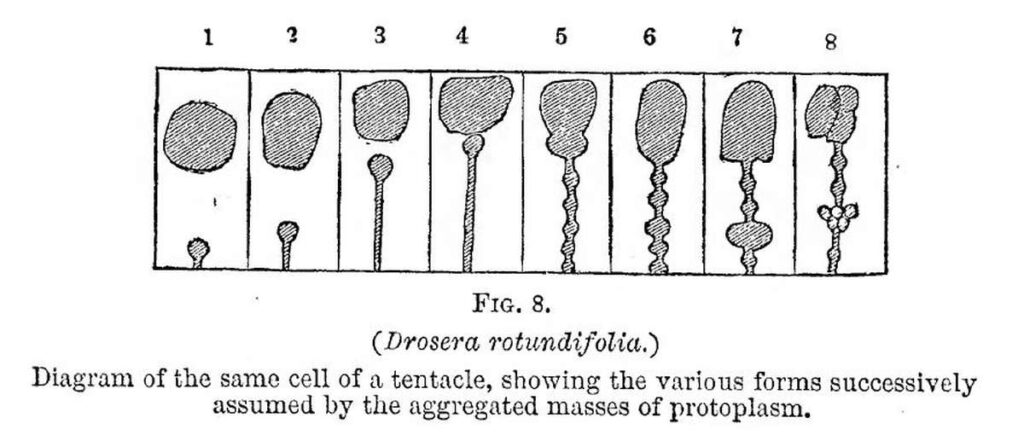
These sketches exhibit some of the more remarkable changes which the protoplasm undergoes. At first, there was at the base of the cell 1, a little mass on a short footstalk, and a larger mass near the upper end, and these seemed quite separate.
Nevertheless, they may have been connected by a fine and invisible thread of protoplasm, for on two other occasions, whilst one mass was rapidly increasing, and another in the same cell rapidly decreasing, I was able by varying the light and using a high power, to detect a connecting thread of extreme tenuity, which evidently served as the channel of communication between the two.
On the other hand, such connecting threads are sometimes seen to break, and their extremities then quickly become club-headed. The other sketches in fig. 8 show the forms successively assumed.
Shortly after the purple fluid within the cells has become aggregated, the little masses float about in a colourless or almost colourless fluid; and the layer of white granular protoplasm which flows along the walls can now be seen much more distinctly.
The stream flows at an irregular rate, up one wall and down the opposite one, generally at a slower rate across the narrow ends of the elongated cells, and so round and round. But the current sometimes ceases. The movement is often in waves, and their crests sometimes stretch almost across the whole width of the cell, and then sink down again.
Small spheres of protoplasm, apparently quite free, are often driven by the current round the cells; and filaments attached to the central masses are swayed to and fro, as if struggling to escape. Altogether, one of these cells with the ever changing central masses, and with the layer of protoplasm flowing round the walls, presents a wonderful scene of vital activity.
Many observations were made on the contents of the cells whilst undergoing the process of aggregation, but I shall detail only a few cases under different heads. A small portion of a leaf was cut off, placed under a high power, and the glands very gently pressed under a compressor.
In 15 m. I distinctly saw extremely minute spheres of protoplasm aggregating themselves in the purple fluid; these rapidly increased in size, both within the cells of the glands and of the upper ends of the pedicels. Particles of glass, cork, and cinders were also placed on the glands of many tentacles; in 1 hr. several of them were inflected, but after 1 hr. 35 m. there was no aggregation.
Other tentacles with these particles were examined after 8 hrs., and now all their cells had undergone aggregation; so had the cells of the exterior tentacles which had become inflected through the irritation transmitted from the glands of the disc, on which the transported particles rested.
This was likewise the case with the short tentacles round the margins of the disc, which had not as yet become inflected. This latter fact shows that the process of aggregation is independent of the inflection of the tentacles, of which indeed we have other and abundant evidence.
Again, the exterior tentacles on three leaves were carefully examined, and found to contain only homogeneous purple fluid; little bits of thread were then placed on the glands of three of them, and after 22 hrs. the purple fluid in their cells almost down to their bases was aggregated into innumerable, spherical, elongated, or filamentous masses of protoplasm.
The bits of thread had been carried some time previously to the central disc, and this had caused all the other tentacles to become somewhat inflected; and their cells had likewise undergone aggregation, which however, it should be observed, had not as yet extended down to their bases, but was confined to the cells close beneath the glands.
Not only do repeated touches on the glands* and the contact of minute particles cause aggregation, but if glands, without being themselves injured, are cut off from the summits of the pedicels, this induces a moderate amount of aggregation in the headless tentacles, after they have become inflected.
* Judging from an account of M. Heckel’s observations, which I have only just seen quoted in the ‘Gardeners’ Chronicle’ (Oct. 10, 1874), he appears to have observed a similar phenomenon in the stamens of Berberis, after they have been excited by a touch and have moved; for he says, “the contents of each individual cell are collected together in the centre of the cavity.”
On the other hand, if glands are suddenly crushed between pincers, as was tried in six cases, the tentacles seem paralysed by so great a shock, for they neither become inflected nor exhibit any signs of aggregation.
Carbonate of Ammonia.—Of all the causes inducing aggregation, that which, as far as I have seen, acts the quickest, and is the most powerful, is a solution of carbonate of ammonia. Whatever its strength may be, the glands are always affected first, and soon become quite opaque, so as to appear black.
For instance, I placed a leaf in a few drops of a strong solution, namely, of one part to 146 of water (or 3 grs. to 1 oz.), and observed it under a high power. All the glands began to darken in 10 s. (seconds); and in 13 s. were conspicuously darker. In 1 m. extremely small spherical masses of protoplasm could be seen arising in the cells of the pedicels close beneath the glands, as well as in the cushions on which the long-headed marginal glands rest.
In several cases the process travelled down the pedicels for a length twice or thrice as great as that of the glands, in about 10 m. It was interesting to observe the process momentarily arrested at each transverse partition between two cells, and then to see the transparent contents of the cell next below almost flashing into a cloudy mass. In the lower part of the pedicels, the action proceeded slower, so that it took about 20 m. before the cells halfway down the long marginal and submarginal tentacles became aggregated.
We may infer that the carbonate of ammonia is absorbed by the glands, not only from its action being so rapid, but from its effect being somewhat different from that of other salts. As the glands, when excited, secrete an acid belonging to the acetic series, the carbonate is probably at once converted into a salt of this series; and we shall presently see that the acetate of ammonia causes aggregation almost or quite as energetically as does the carbonate.
If a few drops of a solution of one part of the carbonate to 437 of water (or 1 gr. to 1 oz.) be added to the purple fluid which exudes from crushed tentacles, or to paper stained by being rubbed with them, the fluid and the paper are changed into a pale dirty green.
Nevertheless, some purple colour could still be detected after 1 hr. 30 m. within the glands of a leaf left in a solution of twice the above strength (viz. 2 grs. to 1 oz.); and after 24 hrs. the cells of the pedicels close beneath the glands still contained spheres of protoplasm of a fine purple tint. These facts show that the ammonia had not entered as a carbonate, for otherwise the colour would have been discharged.
I have, however, sometimes observed, especially with the long-headed tentacles on the margins of very pale leaves immersed in a solution, that the glands as well as the upper cells of the pedicels were discoloured; and in these cases I presume that the unchanged carbonate had been absorbed.
The appearance above described, of the aggregating process being arrested for a short time at each transverse partition, impresses the mind with the idea of matter passing downwards from cell to cell. But as the cells one beneath the other undergo aggregation when inorganic and insoluble particles are placed on the glands, the process must be, at least in these cases, one of molecular change, transmitted from the glands, independently of the absorption of any matter.
So it may possibly be in the case of the carbonate of ammonia. As, however, the aggregation caused by this salt travels down the tentacles at a quicker rate than when insoluble particles are placed on the glands, it is probable that ammonia in some form is absorbed not only by the glands, but passes down the tentacles.
Having examined a leaf in water, and found the contents of the cells homogeneous, I placed it in a few drops of a solution of one part of the carbonate to 437 of water, and attended to the cells immediately beneath the glands, but did not use a very high power.
No aggregation was visible in 3 m.; but after 15 m. small spheres of protoplasm were formed, more especially beneath the long-headed marginal glands; the process, however, in this case took place with unusual slowness. In 25 m. conspicuous spherical masses were present in the cells of the pedicels for a length about equal to that of the glands; and in 3 hrs. to that of a third or half of the whole tentacle.
If tentacles with cells containing only very pale pink fluid, and apparently but little protoplasm, are placed in a few drops of a weak solution of one part of the carbonate to 4375 of water (1 gr. to 10 oz.), and the highly transparent cells beneath the glands are carefully observed under a high power, these may be seen first to become slightly cloudy from the formation of numberless, only just perceptible, granules, which rapidly grow larger either from coalescence or from attracting more protoplasm from the surrounding fluid.
On one occasion I chose a singularly pale leaf, and gave it, whilst under the microscope, a single drop of a stronger solution of one part to 437 of water; in this case the contents of the cells did not become cloudy, but after 10 m. minute irregular granules of protoplasm could be detected, which soon increased into irregular masses and globules of a greenish or very pale purple tint; but these never formed perfect spheres, though incessantly changing their shapes and positions.
With moderately red leaves the first effect of a solution of the carbonate generally is the formation of two or three, or of several, extremely minute purple spheres which rapidly increase in size. To give an idea of the rate at which such spheres increase in size, I may mention that a rather pale purple leaf placed under a slip of glass was given a drop of a solution of one part to 292 of water, and in 13 m. a few minute spheres of protoplasm were formed; one of these, after 2 hrs. 30 m., was about two-thirds of the diameter of the cell.
After 4 hrs. 25 m. it nearly equalled the cell in diameter; and a second sphere about half as large as the first, together with a few other minute ones, were formed. After 6 hrs. the fluid in which these spheres floated was almost colourless.
After 8 hrs. 35 m. (always reckoning from the time when the solution was first added) four new minute spheres had appeared. Next morning, after 22 hrs., there were, besides the two large spheres, seven smaller ones, floating in absolutely colourless fluid, in which some flocculent greenish matter was suspended.
At the commencement of the process of aggregation, more especially in dark red leaves, the contents of the cells often present a different appearance, as if the layer of protoplasm (primordial utricle) which lines the cells had separated itself and shrunk from the walls; an irregularly shaped purple bag being thus formed.
Other fluids, besides a solution of the carbonate, for instance an infusion of raw meat, produce this same effect. But the appearance of the primordial utricle shrinking from the walls is certainly false;* for before giving the solution, I saw on several occasions that the walls were lined with colourless flowing protoplasm, and after the bag-like masses were formed, the protoplasm was still flowing along the walls in a conspicuous manner, even more so than before.
* With other plants I have often seen what appears to be a true shrinking of the primordial utricle from the walls of the cells, caused by a solution of carbonate of ammonia, as likewise follows from mechanical injuries.
It appeared indeed as if the stream of protoplasm was strengthened by the action of the carbonate, but it was impossible to ascertain whether this was really the case. The bag-like masses, when once formed, soon begin to glide slowly round the cells, sometimes sending out projections which separate into little spheres; other spheres appear in the fluid surrounding the bags, and these travel much more quickly.
That the small spheres are separate is often shown by sometimes one and then another travelling in advance, and sometimes they revolve round each other. I have occasionally seen spheres of this kind proceeding up and down the same side of a cell, instead of round it. The bag-like masses after a time generally divide into two rounded or oval masses, and these undergo the changes shown in figs. 7 and 8. At other times spheres appear within the bags; and these coalesce and separate in an endless cycle of change.
After leaves have been left for several hours in a solution of the carbonate, and complete aggregation has been effected, the stream of protoplasm on the walls of the cells ceases to be visible; I observed this fact repeatedly, but will give only one instance.
A pale purple leaf was placed in a few drops of a solution of one part to 292 of water, and in 2 hrs. some fine purple spheres were formed in the upper cells of the pedicels, the stream of protoplasm round their walls being still quite distinct; but after an additional 4 hrs., during which time many more spheres were formed, the stream was no longer distinguishable on the most careful examination; and this no doubt was due to the contained granules having become united with the spheres, so that nothing was left by which the movement of the limpid protoplasm could be perceived.
But minute free spheres still travelled up and down the cells, showing that there was still a current. So it was next morning, after 22 hrs., by which time some new minute spheres had been formed; these oscillated from side to side and changed their positions, proving that the current had not ceased, though no stream of protoplasm was visible.
On another occasion, however, a stream was seen flowing round the cell-walls of a vigorous, dark-coloured leaf, after it had been left for 24 hrs. in a rather stronger solution, namely, of one part of the carbonate to 218 of water.
This leaf, therefore, was not much or at all injured by an immersion for this length of time in the above solution of two grains to the ounce; and on being afterwards left for 24 hrs. in water, the aggregated masses in many of the cells were re-dissolved, in the same manner as occurs with leaves in a state of nature when they re-expand after having caught insects.
In a leaf which had been left for 22 hrs. in a solution of one part of the carbonate to 292 of water, some spheres of protoplasm (formed by the self-division of a bag-like mass) were gently pressed beneath a covering glass, and then examined under a high power.
They were now distinctly divided by well-defined radiating fissures, or were broken up into separate fragments with sharp edges; and they were solid to the centre. In the larger broken spheres the central part was more opaque, darker-coloured, and less brittle than the exterior; the latter alone being in some cases penetrated by the fissures.
In many of the spheres the line of separation between the outer and inner parts was tolerably well defined. The outer parts were of exactly the same very pale purple tint, as that of the last formed smaller spheres; and these latter did not include any darker central core.
From these several facts we may conclude that when vigorous dark-coloured leaves are subjected to the action of carbonate of ammonia, the fluid within the cells of the tentacles often aggregates exteriorly into coherent viscid matter, forming a kind of bag.
Small spheres sometimes appear within this bag, and the whole generally soon divides into two or more spheres, which repeatedly coalesce and redivide. After a longer or shorter time the granules in the colourless layer of protoplasm, which flows round the walls, are drawn to and unite with the larger spheres, or form small independent spheres; these latter being of a much paler colour, and more brittle than the first aggregated masses.
After the granules of protoplasm have been thus attracted, the layer of flowing protoplasm can no longer be distinguished, though a current of limpid fluid still flows round the walls.
If a leaf is immersed in a very strong, almost concentrated, solution of carbonate of ammonia, the glands are instantly blackened, and they secrete copiously; but no movement of the tentacles ensues. Two leaves thus treated became after 1 hr. flaccid, and seemed killed; all the cells in their tentacles contained spheres of protoplasm, but these were small and discoloured.
Two other leaves were placed in a solution not quite so strong, and there was well-marked aggregation in 30 m. After 24 hrs. the spherical or more commonly oblong masses of protoplasm became opaque and granular, instead of being as usual translucent; and in the lower cells there were only innumerable minute spherical granules. It was evident that the strength of the solution had interfered with the completion of the process, as we shall see likewise follows from too great heat.
All the foregoing observations relate to the exterior tentacles, which are of a purple colour; but the green pedicels of the short central tentacles are acted on by the carbonate, and by an infusion of raw meat, in exactly the same manner, with the sole difference that the aggregated masses are of a greenish colour; so that the process is in no way dependent on the colour of the fluid within the cells.
Finally, the most remarkable fact with respect to this salt is the extraordinary small amount which suffices to cause aggregation. Full details will be given in the seventh chapter, and here it will be enough to say that with a sensitive leaf the absorption by a gland of 1/134400 of a grain (.000482 mgr.) is enough to cause in the course of one hour well-marked aggregation in the cells immediately beneath the gland.
The Effects of certain other Salts and Fluids.—Two leaves were placed in a solution of one part of acetate of ammonia to about 146 of water, and were acted on quite as energetically, but perhaps not quite so quickly, as by the carbonate.
After 10 m. the glands were black, and in the cells beneath them there were traces of aggregation, which after 15 m. was well marked, extending down the tentacles for a length equal to that of the glands. After 2 hrs. the contents of almost all the cells in all the tentacles were broken up into masses of protoplasm.
A leaf was immersed in a solution of one part of oxalate of ammonia to 146 of water; and after 24 m. some, but not a conspicuous, change could be seen within the cells beneath the glands. After 47 m. plenty of spherical masses of protoplasm were formed, and these extended down the tentacles for about the length of the glands. This salt, therefore, does not act so quickly as the carbonate.
With respect to the citrate of ammonia, a leaf was placed in a little solution of the above strength, and there was not even a trace of aggregation in the cells beneath the glands, until 56 m. had elapsed; but it was well marked after 2 hrs. 20 m. On another occasion a leaf was placed in a stronger solution, of one part of the citrate to 109 of water (4 grs. to 1 oz.), and at the same time another leaf in a solution of the carbonate of the same strength.
The glands of the latter were blackened in less than 2 m., and after 1 hr. 45 m. the aggregated masses, which were spherical and very dark-coloured, extended down all the tentacles, for between half and two-thirds of their lengths; whereas in the leaf immersed in the citrate the glands, after 30 m., were of a dark red, and the aggregated masses in the cells beneath them pink and elongated. After 1 hr. 45 m. these masses extended down for only about one-fifth or one-fourth of the length of the tentacles.
Two leaves were placed, each in ten minims of a solution of one part of nitrate of ammonia to 5250 of water (1 gr. to 12 oz.), so that each leaf received 1/576 of a grain (.1124 mgr.). This quantity caused all the tentacles to be inflected, but after 24 hrs. there was only a trace of aggregation.
One of these same leaves was then placed in a weak solution of the carbonate, and after 1 hr. 45 m. the tentacles for half their lengths showed an astonishing degree of aggregation.
Two other leaves were then placed in a much stronger solution of one part of the nitrate to 146 of water (3 grs. to 1 oz.); in one of these there was no marked change after 3 hrs.; but in the other there was a trace of aggregation after 52 m., and this was plainly marked after 1 hr. 22 m., but even after 2 hrs. 12 m. there was certainly not more aggregation than would have followed from an immersion of from 5 m. to 10 m. in an equally strong solution of the carbonate.
Lastly, a leaf was placed in thirty minims of a solution of one part of phosphate of ammonia to 43,750 of water (1 gr. to 100 oz.), so that it received 1/1600 of a grain (.04079 mgr.); this soon caused the tentacles to be strongly inflected; and after 24 hrs. the contents of the cells were aggregated into oval and irregularly globular masses, with a conspicuous current of protoplasm flowing round the walls. But after so long an interval aggregation would have ensued, whatever had caused inflection.
Only a few other salts, besides those of ammonia, were tried in relation to the process of aggregation. A leaf was placed in a solution of one part of chloride of sodium to 218 of water, and after 1 hr. the contents of the cells were aggregated into small, irregularly globular, brownish masses; these after 2 hrs. were almost disintegrated and pulpy.
It was evident that the protoplasm had been injuriously affected; and soon afterwards some of the cells appeared quite empty. These effects differ altogether from those produced by the several salts of ammonia, as well as by various organic fluids, and by inorganic particles placed on the glands.
A solution of the same strength of carbonate of soda and carbonate of potash acted in nearly the same manner as the chloride; and here again, after 2 hrs. 30 m., the outer cells of some of the glands had emptied themselves of their brown pulpy contents. We shall see in the eighth chapter that solutions of several salts of soda of half the above strength cause inflection, but do not injure the leaves.
Weak solutions of sulphate of quinine, of nicotine, camphor, poison of the cobra, &c., soon induce well-marked aggregation; whereas certain other substances (for instance, a solution of curare) have no such tendency.
Many acids, though much diluted, are poisonous; and though, as will be shown in the eighth chapter, they cause the tentacles to bend, they do not excite true aggregation. Thus leaves were placed in a solution of one part of benzoic acid to 437 of water; and in 15 m. the purple fluid within the cells had shrunk a little from the walls, yet when carefully examined after 1 hr. 20 m., there was no true aggregation; and after 24 hrs. the leaf was evidently dead.
Other leaves in iodic acid, diluted to the same degree, showed after 2 hrs. 15 m. the same shrunken appearance of the purple fluid within the cells; and these, after 6 hrs. 15 m., were seen under a high power to be filled with excessively minute spheres of dull reddish protoplasm, which by the next morning, after 24 hrs., had almost disappeared, the leaf being evidently dead.
Nor was there any true aggregation in leaves immersed in propionic acid of the same strength; but in this case the protoplasm was collected in irregular masses towards the bases of the lower cells of the tentacles.
A filtered infusion of raw meat induces strong aggregation, but not very quickly. In one leaf thus immersed there was a little aggregation after 1 hr. 20 m., and in another after 1 hr. 50 m. With other leaves a considerably longer time was required: for instance, one immersed for 5 hrs. showed no aggregation, but was plainly acted on in 5 m.; when placed in a few drops of a solution of one part of carbonate of ammonia to 146 of water.
Some leaves were left in the infusion for 24 hrs., and these became aggregated to a wonderful degree, so that the inflected tentacles presented to the naked eye a plainly mottled appearance. The little masses of purple protoplasm were generally oval or beaded, and not nearly so often spherical as in the case of leaves subjected to carbonate of ammonia.
They underwent incessant changes of form; and the current of colourless protoplasm round the walls was conspicuously plain after an immersion of 25 hrs. Raw meat is too powerful a stimulant, and even small bits generally injure, and sometimes kill, the leaves to which they are given: the aggregated masses of protoplasm become dingy or almost colourless, and present an unusual granular appearance, as is likewise the case with leaves which have been immersed in a very strong solution of carbonate of ammonia.
A leaf placed in milk had the contents of its cells somewhat aggregated in 1 hr. Two other leaves, one immersed in human saliva for 2 hrs. 30 m., and another in unboiled white of egg for 1 hr. 30 m., were not action on in this manner; though they undoubtedly would have been so, had more time been allowed. These same two leaves, on being afterwards placed in a solution of carbonate of ammonia (3 grs. to 1 oz.), had their cells aggregated, the one in 10 m. and the other in 5 m.
Several leaves were left for 4 hrs. 30 m. in a solution of one part of white sugar to 146 of water, and no aggregation ensued; on being placed in a solution of this same strength of carbonate of ammonia, they were acted on in 5 m.; as was likewise a leaf which had been left for 1 hr. 45 m. in a moderately thick solution of gum arabic.
Several other leaves were immersed for some hours in denser solutions of sugar, gum, and starch, and they had the contents of their cells greatly aggregated. This effect may be attributed to exosmose; for the leaves in the syrup became quite flaccid, and those in the gum and starch somewhat flaccid, with their tentacles twisted about in the most irregular manner, the longer ones like corkscrews.
We shall hereafter see that solutions of these substances, when placed on the discs of leaves, do not incite inflection. Particles of soft sugar were added to the secretion round several glands and were soon dissolved, causing a great increase of the secretion, no doubt by exosmose; and after 24 hrs. the cells showed a certain amount of aggregation, though the tentacles were not inflected.
Glycerine causes in a few minutes well-pronounced aggregation, commencing as usual within the glands and then travelling down the tentacles; and this I presume may be attributed to the strong attraction of this substance for water. Immersion for several hours in water causes some degree of aggregation.
Twenty leaves were first carefully examined, and re-examined after having been left immersed in distilled water for various periods, with the following results. It is rare to find even a trace of aggregation until 4 or 5 and generally not until several more hours have elapsed.
When however a leaf becomes quickly inflected in water, as sometimes happens, especially during very warm weather, aggregation may occur in little over 1 hr. In all cases leaves left in water for more than 24 hrs. have their glands blackened, which shows that their contents are aggregated; and in the specimens which were carefully examined, there was fairly well-marked aggregation in the upper cells of the pedicels.
These trials were made with cut off-leaves, and it occurred to me that this circumstance might influence the result, as the footstalks would not perhaps absorb water quickly enough to supply the glands as they continued to secrete. But this view was proved erroneous, for a plant with uninjured roots, bearing four leaves, was submerged in distilled water for 47 hrs., and the glands were blackened, though the tentacles were very little inflected.
In one of these leaves there was only a slight degree of aggregation in the tentacles; in the second rather more, the purple contents of the cells being a little separated from the walls; in the third and fourth, which were pale leaves, the aggregation in the upper parts of the pedicels was well marked.
In these leaves the little masses of protoplasm, many of which were oval, slowly changed their forms and positions; so that a submergence for 47 hrs. had not killed the protoplasm. In a previous trial with a submerged plant, the tentacles were not in the least inflected.
Heat induces aggregation. A leaf, with the cells of the tentacles containing only homogeneous fluid, was waved about for 1 m. in water at 130° Fahr. (54.4° Cent.) and was then examined under the microscope as quickly as possible, that is in 2 m. or 3 m.; and by this time the contents of the cells had undergone some degree of aggregation.
A second leaf was waved for 2 m. in water at 125° (51.6° Cent.) and quickly examined as before; the tentacles were well inflected; the purple fluid in all the cells had shrunk a little from the walls, and contained many oval and elongated masses of protoplasm, with a few minute spheres.
A third leaf was left in water at 125°, until it cooled, and when examined after 1 hr. 45 m., the inflected tentacles showed some aggregation, which became after 3 hrs. more strongly marked, but did not subsequently increase.
Lastly, a leaf was waved for 1 m. in water at 120° (48.8° Cent.) and then left for 1 hr. 26 m. in cold water; the tentacles were but little inflected, and there was only here and there a trace of aggregation. In all these and other trials with warm water the protoplasm showed much less tendency to aggregate into spherical masses than when excited by carbonate of ammonia.
Redissolution of the Aggregated Masses of Protoplasm.—As soon as tentacles which have clasped an insect or any inorganic object, or have been in any way excited, have fully re-expanded, the aggregated masses of protoplasm are redissolved and disappear; the cells being now refilled with homogeneous purple fluid as they were before the tentacles were inflected.
The process of redissolution in all cases commences at the bases of the tentacles, and proceeds up them towards the glands. In old leaves, however, especially in those which have been several times in action, the protoplasm in the uppermost cells of the pedicels remains in a permanently more or less aggregated condition.
In order to observe the process of redissolution, the following observations were made: a leaf was left for 24 hrs. in a little solution of one part of carbonate of ammonia to 218 of water, and the protoplasm was as usual aggregated into numberless purple spheres, which were incessantly changing their forms.
The leaf was then washed and placed in distilled water, and after 3 hrs. 15 m. some few of the spheres began to show by their less clearly defined edges signs of redissolution. After 9 hrs. many of them had become elongated, and the surrounding fluid in the cells was slightly more coloured, showing plainly that redissolution had commenced.
After 24 hrs., though many cells still contained spheres, here and there one could be seen filled with purple fluid, without a vestige of aggregated protoplasm; the whole having been redissolved. A leaf with aggregated masses, caused by its having been waved for 2 m. in water at the temperature of 125° Fahr., was left in cold water, and after 11 hrs. the protoplasm showed traces of incipient redissolution.
When again examined three days after its immersion in the warm water, there was a conspicuous difference, though the protoplasm was still somewhat aggregated. Another leaf, with the contents of all the cells strongly aggregated from the action of a weak solution of phosphate of ammonia, was left for between three and four days in a mixture (known to be innocuous) of one drachm of alcohol to eight drachms of water, and when re-examined every trace of aggregation had disappeared, the cells being now filled with homogeneous fluid.
We have seen that leaves immersed for some hours in dense solutions of sugar, gum, and starch, have the contents of their cells greatly aggregated, and are rendered more or less flaccid, with the tentacles irregularly contorted. These leaves, after being left for four days in distilled water, became less flaccid, with their tentacles partially re-expanded, and the aggregated masses of protoplasm were partially redissolved.
A leaf with its tentacles closely clasped over a fly, and with the contents of the cells strongly aggregated, was placed in a little sherry wine; after 2 hrs. several of the tentacles had re-expanded, and the others could by a mere touch be pushed back into their properly expanded positions, and now all traces of aggregation had disappeared, the cells being filled with perfectly homogeneous pink fluid. The redissolution in these cases may, I presume, be attributed to endosmose.
On the Proximate Causes of the Process of Aggregation
As most of the stimulants which cause the inflection of the tentacles likewise induce aggregation in the contents of their cells, this latter process might be thought to be the direct result of inflection; but this is not the case.
If leaves are placed in rather strong solutions of carbonate of ammonia, for instance of three or four, and even sometimes of only two grains to the ounce of water (i.e. one part to 109, or 146, or 218, of water), the tentacles are paralysed, and do not become inflected, yet they soon exhibit strongly marked aggregation.
Moreover, the short central tentacles of a leaf which has been immersed in a weak solution of any salt of ammonia, or in any nitrogenous organic fluid, do not become in the least inflected; nevertheless they exhibit all the phenomena of aggregation. On the other hand, several acids cause strongly pronounced inflection, but no aggregation.
It is an important fact that when an organic or inorganic object is placed on the glands of the disc, and the exterior tentacles are thus caused to bend inwards, not only is the secretion from the glands of the latter increased in quantity and rendered acid, but the contents of the cells of their pedicels become aggregated.
The process always commences in the glands, although these have not as yet touched any object. Some force or influence must, therefore, be transmitted from the central glands to the exterior tentacles, first to near their bases causing this part to bend, and next to the glands causing them to secrete more copiously. After a short time the glands, thus indirectly excited, transmit or reflect some influence down their own pedicels, inducing aggregation in cell beneath cell to their bases.
It seems at first sight a probable view that aggregation is due to the glands being excited to secrete more copiously, so that sufficient fluid is not left in their cells, and in the cells of the pedicels, to hold the protoplasm in solution. In favour of this view is the fact that aggregation follows the inflection of the tentacles, and during the movement the glands generally, or, as I believe, always, secrete more copiously than they did before.
Again, during the re-expansion of the tentacles, the glands secrete less freely, or quite cease to secrete, and the aggregated masses of protoplasm are then redissolved. Moreover, when leaves are immersed in dense vegetable solutions, or in glycerine, the fluid within the gland-cells passes outwards, and there is aggregation; and when the leaves are afterwards immersed in water, or in an innocuous fluid of less specific gravity than water, the protoplasm is redissolved, and this, no doubt, is due to endosmose.
Opposed to this view, that aggregation is caused by the outward passage of fluid from the cells, are the following facts. There seems no close relation between the degree of increased secretion and that of aggregation.
Thus a particle of sugar added to the secretion round a gland causes a much greater increase of secretion, and much less aggregation, than does a particle of carbonate of ammonia given in the same manner. It does not appear probable that pure water would cause much exosmose, and yet aggregation often follows from an immersion in water of between 16 hrs. and 24 hrs., and always after from 24 hrs. to 48 hrs.
Still less probable is it that water at a temperature of from 125° to 130° Fahr. (51.6° to 54.4° Cent.) should cause fluid to pass, not only from the glands, but from all the cells of the tentacles down to their bases, so quickly that aggregation is induced within 2 m. or 3 m.
Another strong argument against this view is, that, after complete aggregation, the spheres and oval masses of protoplasm float about in an abundant supply of thin colourless fluid; so that at least the latter stages of the process cannot be due to the want of fluid to hold the protoplasm in solution.
There is still stronger evidence that aggregation is independent of secretion; for the papillae, described in the first chapter, with which the leaves are studded are not glandular, and do not secrete, yet they rapidly absorb carbonate of ammonia or an infusion of raw meat, and their contents then quickly undergo aggregation, which afterwards spreads into the cells of the surrounding tissues.
We shall hereafter see that the purple fluid within the sensitive filaments of Dionaea, which do not secrete, likewise undergoes aggregation from the action of a weak solution of carbonate of ammonia.
The process of aggregation is a vital one; by which I mean that the contents of the cells must be alive and uninjured to be thus affected, and they must be in an oxygenated condition for the transmission of the process at the proper rate. Some tentacles in a drop of water were strongly pressed beneath a slip of glass; many of the cells were ruptured, and pulpy matter of a purple colour, with granules of all sizes and shapes, exuded, but hardly any of the cells were completely emptied.
I then added a minute drop of a solution of one part of carbonate of ammonia to 109 of water, and after 1 hr. examined the specimens. Here and there a few cells, both in the glands and in the pedicels, had escaped being ruptured, and their contents were well aggregated into spheres which were constantly changing their forms and positions, and a current could still be seen flowing along the walls; so that the protoplasm was alive.
On the other hand, the exuded matter, which was now almost colourless instead of being purple, did not exhibit a trace of aggregation. Nor was there a trace in the many cells which were ruptured, but which had not been completely emptied of their contents.
Though I looked carefully, no signs of a current could be seen within these ruptured cells. They had evidently been killed by the pressure; and the matter which they still contained did not undergo aggregation any more than that which had exuded. In these specimens, as I may add, the individuality of the life of each cell was well illustrated.
A full account will be given in the next chapter of the effects of heat on the leaves, and I need here only state that leaves immersed for a short time in water at a temperature of 120° Fahr. (48.8° Cent.), which, as we have seen, does not immediately induce aggregation, were then placed in a few drops of a strong solution of one part of carbonate of ammonia to 109 of water, and became finely aggregated.
On the other hand, leaves, after an immersion in water at 150° (65.5° Cent.), on being placed in the same strong solution, did not undergo aggregation, the cells becoming filled with brownish, pulpy, or muddy matter. With leaves subjected to temperatures between these two extremes of 120° and 150° Fahr. (48.8° and 65.5° Cent.), there were gradations in the completeness of the process; the former temperature not preventing aggregation from the subsequent action of carbonate of ammonia, the latter quite stopping it.
Thus, leaves immersed in water, heated to 130° (54.4° Cent.), and then in the solution, formed perfectly defined spheres, but these were decidedly smaller than in ordinary cases. With other leaves heated to 140° (60° Cent.), the spheres were extremely small, yet well defined, but many of the cells contained, in addition, some brownish pulpy matter. In two cases of leaves heated to 145° (62.7° Cent.), a few tentacles could be found with some of their cells containing a few minute spheres; whilst the other cells and other whole tentacles included only the brownish, disintegrated or pulpy matter.
The fluid within the cells of the tentacles must be in an oxygenated condition, in order that the force or influence which induces aggregation should be transmitted at the proper rate from cell to cell. A plant, with its roots in water, was left for 45 m. in a vessel containing 122 oz. of carbonic acid.
A leaf from this plant, and, for comparison, one from a fresh plant, were both immersed for 1 hr. in a rather strong solution of carbonate of ammonia. They were then compared, and certainly there was much less aggregation in the leaf which had been subjected to the carbonic acid than in the other.
Another plant was exposed in the same vessel for 2 hrs. to carbonic acid, and one of its leaves was then placed in a solution of one part of the carbonate to 437 of water; the glands were instantly blackened, showing that they had absorbed, and that their contents were aggregated; but in the cells close beneath the glands there was no aggregation even after an interval of 3 hrs.
After 4 hrs. 15 m. a few minute spheres of protoplasm were formed in these cells, but even after 5 hrs. 30 m. the aggregation did not extend down the pedicels for a length equal to that of the glands. After numberless trials with fresh leaves immersed in a solution of this strength, I have never seen the aggregating action transmitted at nearly so slow a rate.
Another plant was left for 2 hrs. in carbonic acid, but was then exposed for 20 m. to the open air, during which time the leaves, being of a red colour, would have absorbed some oxygen. One of them, as well as a fresh leaf for comparison, were now immersed in the same solution as before.
The former were looked at repeatedly, and after an interval of 65 m. a few spheres of protoplasm were first observed in the cells close beneath the glands, but only in two or three of the longer tentacles. After 3 hrs. the aggregation had travelled down the pedicels of a few of the tentacles for a length equal to that of the glands.
On the other hand, in the fresh leaf similarly treated, aggregation was plain in many of the tentacles after 15 m.; after 65 m. it had extended down the pedicels for four, five, or more times the lengths of the glands; and after 3 hrs. the cells of all the tentacles were affected for one-third or one-half of their entire lengths.
Hence there can be no doubt that the exposure of leaves to carbonic acid either stops for a time the process of aggregation, or checks the transmission of the proper influence when the glands are subsequently excited by carbonate of ammonia; and this substance acts more promptly and energetically than any other.
It is known that the protoplasm of plants exhibits its spontaneous movements only as long as it is in an oxygenated condition; and so it is with the white corpuscles of the blood, only as long as they receive oxygen from the red corpuscles;* but the cases above given are somewhat different, as they relate to the delay in the generation or aggregation of the masses of protoplasm by the exclusion of oxygen.
* With respect to plants, Sachs, ‘Trait de Bot.’ 3rd edit., 1874, p. 864. On blood corpuscles, see ‘Quarterly Journal of Microscopical Science,’ April 1874, p. 185.’
A Summary and Concluding Remarks.—The process of aggregation is independent of the inflection of the tentacles and of increased secretion from the glands. It commences within the glands, whether these have been directly excited, or indirectly by a stimulus received from other glands.
In both cases the process is transmitted from cell to cell down the whole length of the tentacles, being arrested for a short time at each transverse partition. With pale-coloured leaves the first change which is perceptible, but only under a high power, is the appearance of the finest granules in the fluid within the cells, making it slightly cloudy. These granules soon aggregate into small globular masses.
I have seen a cloud of this kind appear in 10 s. after a drop of a solution of carbonate of ammonia had been given to a gland. With dark red leaves the first visible change often is the conversion of the outer layer of the fluid within the cells into bag-like masses. The aggregated masses, however they may have been developed, incessantly change their forms and positions.
They are not filled with fluid, but are solid to their centres. Ultimately the colourless granules in the protoplasm which flows round the walls coalesce with the central spheres or masses; but there is still a current of limpid fluid flowing within the cells.
As soon as the tentacles fully re-expand, the aggregated masses are redissolved, and the cells become filled with homogeneous purple fluid, as they were at first. The process of redissolution commences at the bases of the tentacles, thence proceeding upwards to the glands; and, therefore, in a reversed direction to that of aggregation.
Aggregation is excited by the most diversified causes,—by the glands being several times touched,—by the pressure of particles of any kind, and as these are supported by the dense secretion, they can hardly press on the glands with the weight of a millionth of a grain,*—by the tentacles being cut off close beneath the glands,—by the glands absorbing various fluids or matter dissolved out of certain bodies,—by exosmose,—and by a certain degree of heat.
* According to Hofmeister (as quoted by Sachs, ‘Trait de Bot.’ 1874, p. 958), very slight pressure on the cell-membrane arrests immediately the movements of the protoplasm, and even determines its separation from the walls. But the process of aggregation is a different phenomenon, as it relates to the contents of the cells, and only secondarily to the layer of protoplasm which flows along the walls; though no doubt the effects of pressure or of a touch on the outside must be transmitted through this layer.
On the other hand, a temperature of about 150° Fahr. (65.5° Cent.) does not excite aggregation; nor does the sudden crushing of a gland. If a cell is ruptured, neither the exuded matter nor that which still remains within the cell undergoes aggregation when carbonate of ammonia is added.
A very strong solution of this salt and rather large bits of raw meat prevent the aggregated masses being well developed. From these facts we may conclude that the protoplasmic fluid within a cell does not become aggregated unless it be in a living state, and only imperfectly if the cell has been injured. We have also seen that the fluid must be in an oxygenated state, in order that the process of aggregation should travel from cell to cell at the proper rate.
Various nitrogenous organic fluids and salts of ammonia induce aggregation, but in different degrees and at very different rates. Carbonate of ammonia is the most powerful of all known substances; the absorption of 1/134400 of a grain (.000482 mg.) by a gland suffices to cause all the cells of the same tentacle to become aggregated. The first effect of the carbonate and of certain other salts of ammonia, as well as of some other fluids, is the darkening or blackening of the glands.
This follows even from long immersion in cold distilled water. It apparently depends in chief part on the strong aggregation of their cell-contents, which thus become opaque, and do not reflect light.
Some other fluids render the glands of a brighter red; whilst certain acids, though much diluted, the poison of the cobra-snake, &c., make the glands perfectly white and opaque; and this seems to depend on the coagulation of their contents without any aggregation. Nevertheless, before being thus affected, they are able, at least in some cases, to excite aggregation in their own tentacles.
That the central glands, if irritated, send centrifugally some influence to the exterior glands, causing them to send back a centripetal influence inducing aggregation, is perhaps the most interesting fact given in this chapter. But the whole process of aggregation is in itself a striking phenomenon.
Whenever the peripheral extremity of a nerve is touched or pressed, and a sensation is felt, it is believed that an invisible molecular change is sent from one end of the nerve to the other; but when a gland of Drosera is repeatedly touched or gently pressed, we can actually see a molecular change proceeding from the gland down the tentacle; though this change is probably of a very different nature from that in a nerve.
Finally, as so many and such widely different causes excite aggregation, it would appear that the living matter within the gland-cells is in so unstable a condition that almost any disturbance suffices to change its molecular nature, as in the case of certain chemical compounds. And this change in the glands, whether excited directly, or indirectly by a stimulus received from other glands, is transmitted from cell to cell, causing granules of protoplasm either to be actually generated in the previously limpid fluid or to coalesce and thus to become visible.
Supplementary Observations on the Process of Aggregation in the Roots of Plants
It will hereafter be seen that a weak solution of the carbonate of ammonia induces aggregation in the cells of the roots of Drosera; and this led me to make a few trials on the roots of other plants. I dug up in the latter part of October the first weed which I met with, viz. Euphorbia peplus, being careful not to injure the roots; these were washed and placed in a little solution of one part of carbonate of ammonia to 146 of water.
In less than one minute I saw a cloud travelling from cell to cell up the roots, with wonderful rapidity. After from 8 m. to 9 m. the fine granules, which caused this cloudy appearance, became aggregated towards the extremities of the roots into quadrangular masses of brown matter; and some of these soon changed their forms and became spherical. Some of the cells, however, remained unaffected.
I repeated the experiment with another plant of the same species, but before I could get the specimen into focus under the microscope, clouds of granules and quadrangular masses of reddish and brown matter were formed, and had run far up all the roots. A fresh root was now left for 18 hrs. in a drachm of a solution of one part of the carbonate to 437 of water, so that it received 1/8 of a grain, or 2.024 mg.
When examined, the cells of all the roots throughout their whole length contained aggregated masses of reddish and brown matter. Before making these experiments, several roots were closely examined, and not a trace of the cloudy appearance or of the granular masses could be seen in any of them. Roots were also immersed for 35 m. in a solution of one part of carbonate of potash to 218 of water; but this salt produced no effect.
I may here add that thin slices of the stem of the Euphorbia were placed in the same solution, and the cells which were green instantly became cloudy, whilst others which were before colourless were clouded with brown, owing to the formation of numerous granules of this tint. I have also seen with various kinds of leaves, left for some time in a solution of carbonate of ammonia, that the grains of chlorophyll ran together and partially coalesced; and this seems to be a form of aggregation.
Plants of duck-weed (Lemna) were left for between 30 m. and 45 m. in a solution of one part of this same salt to 146 of water, and three of their roots were then examined. In two of them, all the cells which had previously contained only limpid fluid now included little green spheres.
After from 1 1/2 hr. to 2 hrs. similar spheres appeared in the cells on the borders of the leaves; but whether the ammonia had travelled up the roots or had been directly absorbed by the leaves, I cannot say. As one species, Lemna arrhiza, produces no roots, the latter alternative is perhaps the most probable.
After about 2 1/2 hrs. some of the little green spheres in the roots were broken up into small granules which exhibited Brownian movements. Some duck-weed was also left for 1 hr. 30 m. in a solution of one part of carbonate of potash to 218 of water, and no decided change could be perceived in the cells of the roots; but when these same roots were placed for 25 m. in a solution of carbonate of ammonia of the same strength, little green spheres were formed.
A green marine alga was left for some time in this same solution, but was very doubtfully affected. On the other hand, a red marine alga, with finely pinnated fronds, was strongly affected. The contents of the cells aggregated themselves into broken rings, still of a red colour, which very slowly and slightly changed their shapes, and the central spaces within these rings became cloudy with red granular matter. The facts here given (whether they are new, I know not) indicate that interesting results would perhaps be gained by observing the action of various saline solutions and other fluids on the roots of plants.
More Chapters from Insectivorous Plants by Charles Darwin
Insectivorous Plants Table of Contents
Previous – Chapter 2: The Movements of the Tentacles from the Contact of Solid Bodies
Up next – Chapter 4: The Effects of Heat on the Leaves

